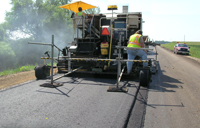TERRA E-News, January 2013 – Volume 7, Number 1
The following innovative technologies were used on the TH 56 reconstruction project.
Stabilized Base—The top 9 inches of existing bituminous along with 1 inch of the existing base were recycled in-place. Subsequently, the top 6 inches of this recycled base was injected with asphalt emulsion to stabilize and strengthen it.
Intelligent Compaction (IC)—All of the rollers used on the project (four on soils and four on bituminous) were instrumented with GPS and machine characteristic recording equipment. This equipment gives rollers operator a screen showing the number of passes they’ve made over any location so they can determine if they missed a location or are over-rolling an area. The system also displays the response to the compaction effort being put into the roadway and the temperature of the surface. This information is useful for producing uniform and long-lasting pavements. These data are also transmitted electronically to MnDOT for a complete record of construction and for further analysis.
Base Strength—Both a light-weight deflectomer (LWD) and a dynamic cone penetrometer (DCP) were used on the base to evaluate its strength during construction to provide acceptance for placement and compaction of the material before it was paved.
Test Rollers—Test rolling of the base is typically performed with a loaded cart, which is pulled down the grade to locate soft spots as determined by the wheel of the cart sinking into the grade. A sonic and a laser system were used on this project to document more accurately the amount and location of any soft locations on the grade.
Roadway Strength—A falling-weight deflectometer (FWD) was used on three 1-mile sections of the road to determine the amount and timing of strength gain of the stabilized base layer. This is a standard tool for roadway evaluations, but the information it provides will be compared to the response that is measured by the rollers during construction.
Pavement Temperature Profiles—Twelve thermal sensors are mounted to the back of the paver to measure and document the temperature of the newly placed mat during construction. The display screen on the back of the paver allows the operator to make real-time adjustments to the process and equipment so the most uniform bituminous can be placed, providing the highest density and smoothness.
Radar—Ground-penetrating radar (GPR) was used to evaluate the thickness of the previously existing pavement so the proper amount could be removed during construction. Also, the radar can be used to determine the density of the newly constructed mat without taking cores through the pavement.
Smoothness—The contractor measured road smoothness after each construction process by driving two lasers down the road to check for rough areas. Problem areas were fixed prior to placement of the final mat. The pavement was also checked for smoothness on the final pavement surface. Contractors can get an incentive or disincentive depending on the smoothness of the final product.
Information Viewing—MnDOT and the Federal Highway Administration are funding the development of a geospatial mapping and viewing software (Veda) in which all the data from the previously mentioned items can be loaded and analyzed. The tremendous amount of data can then be viewed and evaluated.

